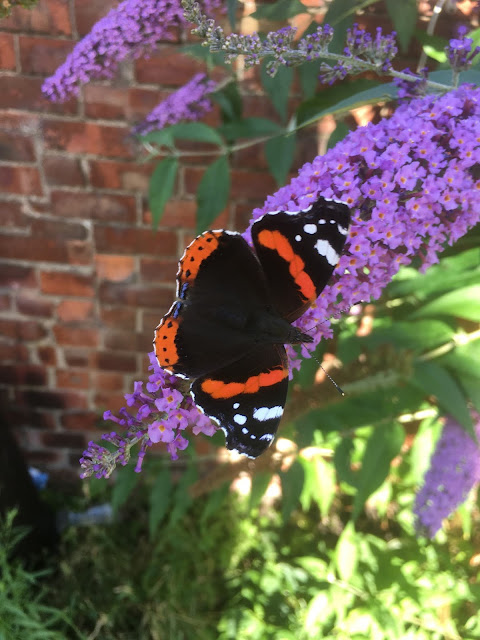I'm a bit surprised that I have got as far as day 19 of this Species Spotlight Challenge before having my first butterfly. I'm not sure why that is, but whatever the reason, today's species is the beautiful and striking Red Admiral (Vanessa atalanta).
Unlike yesterday's species and the other examples given in the blog-post, the 'red' in the name of today's species really is what we would call red these days. However, there is a relatively small amount of it, especially compared to black, which is the main colour. The much rarer White Admiral butterfly is similar in this respect - it is mostly black but with a broken band of white across the wings.
When I was young my mother told me that the Red Admiral got its name because it was the shape of an admiral's hat. Well, although I can sort of see that (with a bit of imagination), it turns out (at least according to Wikipedia) that the name is actually a contraction of an older name, Red Admirable. I presume that this name just means that they are beautiful and to be admired.
The life cycle of Red Admirals in this country is very interesting. Each year, starting in Spring, there are successive waves of adult Red Admirals migrating north from North Africa and mainland Europe. Once they are here, the females start laying eggs, mostly on Stinging Nettles, which the spiky black caterpillars will feed on for three to four weeks before pupating. The first emergence of new adults in this country is usually in about July and they will keep on breeding for as long as they can, and can often be seen flying into October or November. Numbers of Red Admirals in the UK may have increased in recent years and there is even some evidence that they may have started over-wintering in the south of England.
This lovely butterfly is a common sight in gardens but you are much more likely to see them if you have Buddleias (see my Species Spotlight - Day 8 Day 8 - Buddleia), and Ivy (which flowers late in the summer after the Buddleia has finished), although they will also feed on rotten fruit. Allowing some Stinging Nettles to remain unweeded will also increase your chance of seeing this species (as well as several other large butterflies that lay their eggs on Nettles).
The photos here show a Red Admiral feeding ('nectaring') on Buddleia in my garden this afternoon.
 |
| Photo © R. Palin |

No comments:
Post a Comment